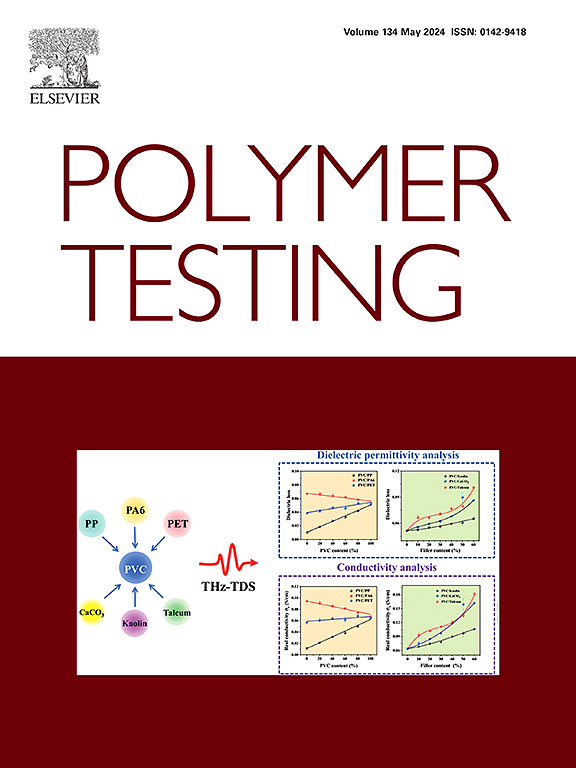Study on 3D printability of PLA/PBAT/PHBV biodegradable blends for packaging applications
IF 5
2区 材料科学
Q1 MATERIALS SCIENCE, CHARACTERIZATION & TESTING
引用次数: 0
Abstract
Additive manufacturing offers a fast and cost-effective pathway to develop new sustainable, multifunctional packaging prototypes. However, the range of biodegradable polymers suitable for this technology is still critically narrow. Poly (3-hydroxybutyrate-co-3-hydroxy valerate) (PHBV) possess favorable barrier, mechanical properties and biodegradability; however, its low thermal stability and poor melt strength pose severe challenges in 3D printing process. On their side, PBAT-rich Ecovio blends provide high ductility and thermal stability but suffer from buckling issues due to excessive flexibility of the filaments. To address these concerns, this study systematically evaluates the role of PHBV in Ecovio-based blends for 3D printing, providing new insights into the relationship between blend composition, processability and dimensional stability, for the development of new packaging prototypes using fused deposition modeling (FDM). The printing temperature (from 200 to 250 °C) and the blends composition (up to 40 % PHBV concentration) were optimized to enhance the printability, the dimensional accuracy and the mechanical properties of the specimens for the target application, based on preliminary characterization of chemical, thermal, rheological and morphological investigations. Results showed that the incorporation of PHBV into the blends at concentrations ≥20 % ensured a decrease in viscosity and adequate rigidity to guarantee successful 3D printing, while Ecovio increased the thermal stability of PHBV and expanded the processing window, enabling the blends to be printed up to 250 °C. Among all, the Ecovio/PHBV 70/30 blend printed at 230 °C demonstrated to be best combination of composition and temperature to achieve better compactness, flexural properties and optimized processability, while minimizing warpage, shrinkage and degradation phenomena, making it a promising candidate for the realization of novel, sustainable packaging prototypes. Finally, overall migration tests demonstrated the compliance of the developed packages to the limits of Regulation (EU) No October 2011 for food contact applications.
包装用PLA/PBAT/PHBV可生物降解共混物的3D打印性能研究
增材制造为开发新的可持续、多功能包装原型提供了一种快速、经济的途径。然而,适用于该技术的可生物降解聚合物的范围仍然非常狭窄。聚(3-羟基丁酸酯-co-3-羟基戊酸酯)(PHBV)具有良好的阻隔性、力学性能和生物降解性;然而,其热稳定性低,熔体强度差,给3D打印工艺带来了严峻的挑战。另一方面,富含pbat的Ecovio共混物具有高延展性和热稳定性,但由于长丝的过度柔韧性而存在屈曲问题。为了解决这些问题,本研究系统地评估了PHBV在3D打印ecovio基共混物中的作用,为共混物成分、可加工性和尺寸稳定性之间的关系提供了新的见解,为使用熔融沉积建模(FDM)开发新的包装原型提供了新的见解。根据初步的化学、热、流变和形态学研究,优化了打印温度(200至250°C)和共混物成分(高达40% PHBV浓度),以提高目标应用样品的打印性、尺寸精度和机械性能。结果表明,在共混物中加入浓度≥20%的PHBV,确保了粘度的降低和足够的刚性,从而保证了3D打印的成功,而Ecovio提高了PHBV的热稳定性,扩大了加工窗口,使共混物能够在高达250°C的温度下打印。其中,在230°C下印刷的Ecovio/PHBV 70/30共混材料被证明是成分和温度的最佳组合,可以实现更好的致密性、弯曲性能和优化的可加工性,同时最大限度地减少翘曲、收缩和降解现象,使其成为实现新型可持续包装原型的有希望的候选者。最后,总体迁移测试表明,开发的包装符合2011年10月第(EU)号法规对食品接触应用的限制。
本文章由计算机程序翻译,如有差异,请以英文原文为准。
求助全文
约1分钟内获得全文
求助全文
来源期刊

Polymer Testing
工程技术-材料科学:表征与测试
CiteScore
10.70
自引率
5.90%
发文量
328
审稿时长
44 days
期刊介绍:
Polymer Testing focuses on the testing, analysis and characterization of polymer materials, including both synthetic and natural or biobased polymers. Novel testing methods and the testing of novel polymeric materials in bulk, solution and dispersion is covered. In addition, we welcome the submission of the testing of polymeric materials for a wide range of applications and industrial products as well as nanoscale characterization.
The scope includes but is not limited to the following main topics:
Novel testing methods and Chemical analysis
• mechanical, thermal, electrical, chemical, imaging, spectroscopy, scattering and rheology
Physical properties and behaviour of novel polymer systems
• nanoscale properties, morphology, transport properties
Degradation and recycling of polymeric materials when combined with novel testing or characterization methods
• degradation, biodegradation, ageing and fire retardancy
Modelling and Simulation work will be only considered when it is linked to new or previously published experimental results.
 求助内容:
求助内容: 应助结果提醒方式:
应助结果提醒方式:


